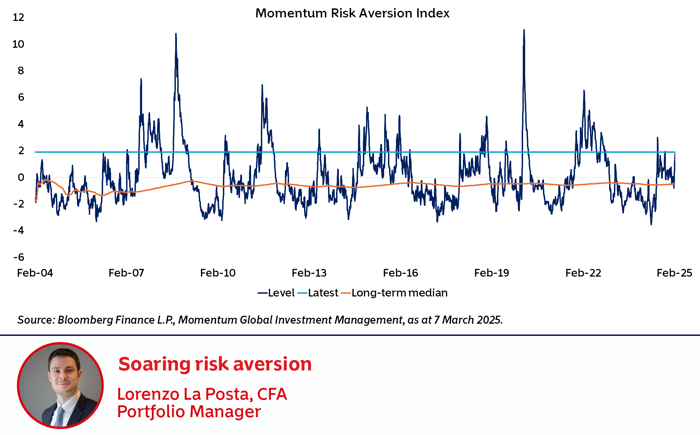
What this chart shows
This chart shows the Momentum Global Investment Management Risk Aversion Index over the past twenty-one years. The Index combines several different measures, such as global credit spreads, and forex and equity implied volatility to gauge what the current level of risk aversion is in markets. Risk aversion can be used as a measure of how tolerant investors are to taking on risk, given current and expected economic and financial conditions. Historically, peaks in risk aversion have taken place during periods of market stress, like during the global financial crisis in 2008, the European crisis in 2011 and the Covid pandemic in 2020, and very often were followed by rallies in risk assets as risk appetite returned in investors’ behaviours. Today, whilst economic conditions are not bad, there is plenty of uncertainty around the path of inflation and interest rates, alongside significant geopolitical tensions. Risk aversion is well above long-term median, in the highest quintile of occurrences.
Why this is important
Risk appetite affects all asset classes differently and understanding how assets react to different types of risk is an important skill for any investor to have, and clearly not all periods of market stress are built the same. Typically, the most volatile assets are the most sensitive to changing risk appetite levels, with excess returns during periods of economic stability and security being countered by excess losses when conditions change for the worse. Very often, peaks in risk aversion coincide with bottoms for risk assets and are very often a contrarian signal, useful for investors to gauge when opportunities are opening or when perhaps riskier assets are oversold. And with a good understanding of how risk affects different securities, an investor can build a portfolio of assets with a diverse range of responses to changing economic conditions. With diversification comes protection and outperformance during periods of uncertainty and volatility.
The week of March 3 to March 7, 2025, was marked by escalating global trade tensions, particularly between the US and its major trading partners, leading to significant market volatility, shifts in fiscal policies, and adjustments in economic forecasts across multiple regions.

-
The S&P 500 experienced its sharpest weekly decline since before the 2024 election, dropping 3.1% as it swung around its 200-day moving average. Consumer confidence continued to take a significant hit amid mounting trade tensions and tariff uncertainty.
-
US Treasury yields rose modestly, fuelled by Germany’s proposal of defence spending that sparked a global bond sell-off.
-
The US economy added 151,000 jobs in February, leading to a slight increase in the unemployment rate to 4.1%, consensus was 4%.
-
Federal Reserve Chair Jerome Powell stated that the US economy remains in a good place, despite trade policy uncertainties.

-
The UK hosted Commonwealth Day at Westminster Abbey, reflecting on global trade and cooperation.
-
Upcoming UK GDP estimates are anticipated, with analysts closely monitoring potential impacts from global trade tensions.
-
The UK Halifax House Price Index came in at 2.9% year-on-year vs 3.1% expected. House prices fell 0.1% in February as the market faces stamp duty hikes being introduced by Chancellor Rachel Reeves next month.
-
UK markets showed resilience despite global trade uncertainties, with investors focusing on domestic economic data, which saw UK Manufacturing PMI for February at 46.9 vs 46.4 expected. However, UK Construction PMI reading of 44.6 was light of the 49.5 expectation

-
Germany announced plans to abandon its strict fiscal discipline, introducing a significant spending package aimed at boosting infrastructure and defence.
-
German 10-year bund yields surged to 2.9%, marking the highest jump in nearly 30 years, influencing bond yields across Europe.
-
European stocks, particularly in the defence sector, rose following Germany's spending announcement and commitments from other European leaders to increase defence budgets.
-
The euro experienced its largest weekly rise against the US dollar since 2009, reflecting renewed investor confidence in Europe.

-
China retaliated against US tariffs and announced tariffs of up to 15% on US agricultural products, including cotton, chicken, corn, and soybeans.
-
Chinese Premier Li Qiang set a GDP growth target of around 5% for 2025 and raised the fiscal deficit to 4% of GDP, signalling a focus on consumer-driven growth.
-
Japan's 10-year government bond yields reached a 16-year high at 1.52%, influenced by global fiscal policy changes and domestic inflation concerns.
-
Oil prices remained stable, while gold prices held steady as investors weighed the impact of tariffs on global supply chains.
